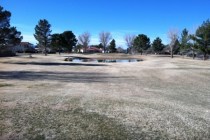Tending golf turf takes attention to detail

It’s 4:30 in the morning, and I’m at Angel Park Golf Club, 100 S. Rampart Blvd. It’s dark outside, but there’s a hubbub of activity going on. There’s an associate mowing the practice green, a kitchen worker heading toward the restaurant, a worker policing the parking lot, a staff member using a blower to clear the main concourse to the clubhouse and equipment is buzzing everywhere.
There are sprinklers watering the course. The city’s lights are glowing in the distance. Three golfers are practicing putting on another green. Come on — it’s dark here.
I’ve come to discover what it takes to prepare a golf course for play every day.
Tom Christy, vice president construction and agronomy for OB Sports Golf Management, drives up in a utility cart.
“Good morning,” he said. “Ready to see what we do? We have 18 full-time employees and nine part-time employees who help get the course ready for play every day.”
First stop is to one of the practice greens to check the speed of the greens.
“We try to target the greens to a 9.5-10 (on the stimpmeter),” Christy said.
A superintendent rolls the ball down the meter in one direction, then again in the opposite direction. The ball rolls an average of 11 feet. Christy takes note. The greens will be fast today.
Next, we visit the maintenance complex. Christy shows me the watering report for the previous night. The 2,000-plus sprinkler heads are individually monitored, any deficient ones are checked and the area hand-watered later in the day. The sprinklers are programmed by an on-site weather station that predicts what amount of water is needed every day to keep the course lush and green. Usual watering times are 24 to 30 minutes daily.
Christy then shows me a weekly schedule of job duties and man hours needed to accomplish the various jobs in opening the courses. The list is 30 items long, including many that need to be done every day. These include mowing the tees and green surrounds, mowing the rough, mowing the greens, spot-raking the bunkers and setting up the course.
Part of Christy’s job is surveying the course prior to the first players teeing off. Today, there is a junior golf event on the Mountain course.
“Hop in and let’s go see the Mountain course,” Christy says.
We drive each hole, Christy’s practiced eye looking for course conditions and potential trouble areas. He’s also checking the pin placements on the green and the greens themselves. He sees some damage to the green area.
“We have a lot of problems with rabbits out here,” he says. “Between the three courses, there’s close to 5,000 rabbits, and they do a lot of harm.”
He shows me several examples of their toil, destroying green edges, urination causing brown patches and even chewing through irrigation drip lines. He’s also looking for hot spots and wet spots that require attention. He watches where birds land — it might be an area that has worm problems. Workers are tending to the greens, changing holes’ locations and raking traps.
Christy also is looking at course conditions for its upcoming overseeding. Overseeding is scheduled to begin Aug. 30 on the Mountain course, followed by the Palm course 13 days later. Overseeding is putting a layer of grass seed over existing grass to promote new growth or replace existing grass with a new type for the winter season. Bermuda grass turns dormant and brown; applying rye grass over the Bermuda grass keeps the course green and attractive. Some 90,000 pounds of it are used for Angel Park.
Christy is a graduate of Oregon State University’s College of Agricultural Sciences, majoring in crop science and soils.
“Basically a farmer’s degree,” he says, chuckling. “What I like about this job is I use both sides of my brain, the technical side and the aesthetic side. Got to keep the courses looking great for the players’ enjoyment, maintaining a clean golf course so players aren’t intimidated when playing our course. Getting there requires the tech side.”
The tech side includes saving water. Angel Park has reduced its water consumption over the last decade by 42 percent. Converting to Xeri scaping has helped. Angel Park covers 294 acres, almost 13 million square feet, and 185 acres are irrigated. Another 75 acres are desert landscaping with drip irrigation.
“That conversion has assisted us in reducing our water usage goals,” Christy says.
Driving back to the maintenance building, Christy tells me of the importance of the pH in the water, the effects of temperature and humidity on course conditions, how they overseed “wall to wall” for best results, how to detect leaks in the lakes and how to keep 130 pieces of motorized equipment up and running.
The courses look great to me.
“How do you do it?” I ask.
“Have great people to help you,” Christy says.
Only one last thought in my mind: It’s much easier just to play the game.
John Asay is a longtime golfer and local freelance writer. Contact him at jasay@reviewjournal.com.












